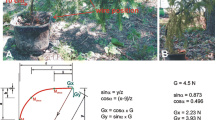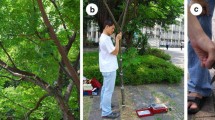Abstract
Land plants have evolved a large number of growth forms and each plant species has a unique morphology. For many tall plants, main stems serve the function of vertical growth while primary and higher order branches are responsible for lateral growth for greater light interception. Herein we search for a mechanical constant for primary branches. Primary branches were sampled from 40 species of trees and shrubs. Among the species sampled, branch lengths ranged from 1.8 to 12.2 m, weights from 0.056 to 16.6 kg, base diameters from 17 to 150 mm, bending moments from 7.1 to 2,200 N-m, and section moduli from 0.039 to 29.0 × 10−3 m3. Primary branches of all 40 tree and shrub species exhibited relatively constant bending stresses along each branch. Moreover stress values among the 40 species were relatively constant at about 11 MPa (mean = 11.1 MPa [range 5.2–18.9]; standard deviation = 3.3 MPa). Furthermore, primary branches without secondary branches attached (1) had similar bending moment distributions as tapered cantilever beams, (2) exhibited relatively constant slope values of stress versus length among all species (stresses increased linearly with length), and (3) exhibited both relatively constant density and relatively constant taper within each species. We conclude that the relatively constant stress of about 11 MPa of primary branches was due solely to the numbers, weights, and distributions of secondary branches and associated higher order branches along primary branches for the 40 plant species. To our knowledge, this is the first publication that shows a unifying mechanical constant for primary branches of plants.






Similar content being viewed by others
Notes
Note that a circular cross-section was assumed. In reality, the cross-sections are elliptical in nature due to the reaction wood. However, this error is quite small. The mean ratio of long radius to short radius (accounting for the reaction wood) was determined to be 1.107 with a standard deviation of 0.175. The error using a circular cross-section compared to using the second moment of area with respect to the major axis was 12.9% with a standard deviation of 26.0%. The error associated with respect to the second moment of area about the minor axis was 7.3% with a standard deviation of 7.78%. Furthermore, these errors are exaggerated because the maximum stresses would actually fall on axes between the major and minor axes, thereby reducing the errors even further.
References
Almeras T, Gril J, Costes E (2002) Bending of apricot-tree branches under the weight of axillary productions: confrontation of a mechanical model to experimental data. Trees 16:5–15
Almeras T, Thibaut A, Gril J (2005) Effect of circumferential heterogeneity of wood maturation strain, modulus of elasticity and radial growth on the regulation of stem orientation in trees. Trees 19:457–467
Baldwin VC, Peterson KD, Burkhart HE, Amateis RL, Doughtery PM (1997) Equations for estimating loblolly pine branch and foliage weight and surface area. Can J For Res 27:918–927
Bertram JE (1989) Size-dependent differential scaling in branches; the mechanical design of trees revisited. Trees 4:241–253
Cannell M, Morgan J, Murray M (1988) Diameters and dry weights of tree shoots: effects of Young’s modulus, taper, deflection and angle. Tree Physiol 4:219–231
Castera P, Mortier V (1991) Growth patterns and bending mechanics of branches. Trees 5:232–238
Dean T, Roberts S, Gilmore D, Maguire D, Long J, O’Hara K, Seymour R (2002) An evaluation of the uniform stress hypothesis based on stem geometry in select North American conifers. Trees 16:559–568
Gilmore DW, Seymour RS, Maguire DA (1996) Foliage-sapwood area relationships for Abies balsamea in central Maine. Can J For Res 26:2071–2079
Keane MG, Weetman GF (1987) Leaf area- sapwood cross-sectional area relationships in repressed stands of lodgepole pine. Can J For Res 17:205–209
King DA (1986) Tree form, height growth and susceptibility to wind damage in Acer saccharum. Ecology 67:980–990
Larson PR (1963) Stem form development of forest trees. For. Sci. Monograph #5. Society of American Foresters
Mattheck C, Bethge K, Schafer JJ (1993) Safety factors in trees. Theor Biol 165:185–189
McMahon TA (1973) Size and shape in biology. Science 179:1201–1204
Milne R, Blackburn P (1989) The elasticity and vertical distribution of stress within stems of Picea sitchensis. Tree Physiol 5:195–205
Morgan J, Cannell M (1987) Structural analysis of tree trunks and branches: tapered cantilever beams subject to large deflections under complex loading. Tree Physiol 3:365–371
Morgan J, Cannell M (1994) Shape of tree stems—a re-examination of the uniform stress hypothesis. Tree Physiol 14:49–55
Niklas K (1992) Plant biomechanics. University of Chicago Press, Chicago
Niklas KJ, Spatz H-C (2000) Wind-induced stresses in cherry trees: evidence against the hypothesis of constant stress levels. Trees 14:230–237
Roberts SD, Long JN (1992) Production efficiency of Abies lasiocarpa: influence of vertical distribution of leaf area. Can J For Res 22:1230–1234
SPSS Institute Inc. (2000) Systat 10 [computer program]. SPSS Institute, Chicago
Wilson B, Archer R (1977) Reaction wood; induction and mechanical action. Ann Rev Plant Physiol 28:23–43
Wilson B, Archer R (1979) Tree design: some biological solutions to mechanical problems. Bioscience 29:293–298
Acknowledgments
The authors gratefully acknowledge the Catherine and Robert Fenton Endowed Chair to L.S. E. for financial contributions to the project. The names of the plant species were verified with the help of personnel at the New York Botanical Garden, New York. The authors gratefully acknowledge the excellent manuscript reviews by (alphabetically) Ralph Amateis, Thomas Dean, and Daniel Gilmore. These reviewers made important contributions to the final manuscript.
Author information
Authors and Affiliations
Corresponding author
Additional information
Communicated by Robert Guy.
Rights and permissions
About this article
Cite this article
Evans, L.S., Kahn-Jetter, Z., Torres, J. et al. Mechanical stresses of primary branches: a survey of 40 woody tree and shrub species. Trees 22, 283–289 (2008). https://doi.org/10.1007/s00468-007-0182-7
Received:
Revised:
Accepted:
Published:
Issue Date:
DOI: https://doi.org/10.1007/s00468-007-0182-7




